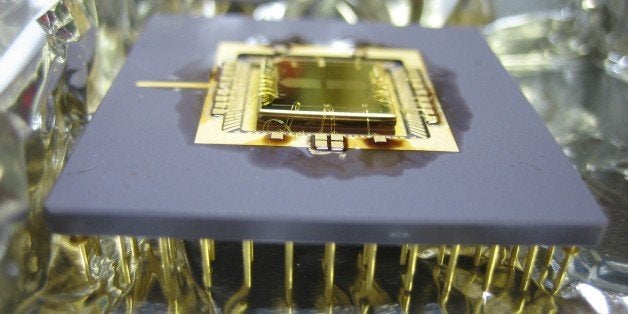
Quantum computers could crack codes and run more complex simulations than current machines, but actually building one is hard to do. The bits that store this complex data don't last long, because they are made of single atoms that get knocked around by stray electrons and photons in the environment.
Enter a team of physicists at Germany's Karlsruhe Institute of Technology. They found a way to get the bits to last long enough to do computations with, using the magnetic properties of a rare earth element called holmium and the symmetry of platinum. The experiment, detailed in tomorrow's (Nov. 14) issue of the journal Nature, is an important step in creating quantum computers and making quantum memory useful.
What makes quantum computers powerful is the nature of the bit. Ordinary computers have bits that are 1 or 0, stored in the current in a circuit or the alignment of magnetic fields on a disk. Due to the weirdness of quantum physics, quantum bits, called qubits, can be both 0 and 1 at the same time. That means a quantum computer can do certain kinds of calculations much, much faster. [Wacky Physics: The Coolest Quantum Particles Explained]
One way for qubits to store information in the so-called spin magnetic moments of atoms. Elementary particles such as electrons can have spins that are either up or down. The total spins of the electrons — each has a spin of one-half — will induce the magnetic moment, which is a way of measuring how much torque a magnetic field might exert on a loop of wire. In atoms, the moment has a direction, just like the spins, and it is either up or down.
Magnetic moments
In the study, led by Toshio Miyamachi, the researchers placed a single atom of holmium on a sheet of platinum with a scanning tunneling microscope. The holmium atom's moments were in a certain state, either up or down. That up or down state represented a bit of information, a 1 or 0 that makes up the language of computers. [Facts About Rare Earth Elements (Infographic)]
To cut down on the chances that a stray photon or electron would interact with the holmium atom, the whole apparatus operates at near absolute zero temperatures.
Ordinarily they would have expected the holmium's magnetic moment state to last a few milliseconds at most. Physicist Wulf Wulfhekel, whose lab did the work, told LiveScience that other research groups have managed that. But his lab group managed to keep the holmium in a given state for about 10 minutes. To a computer, that's a long time.
"One of the main problems with quantum computers is that the quantum bit loses its information rather quickly… In our case, you would have 10 minutes time to perform the calculation," Wulfhekel wrote in an email.
The key to the long-lasting spin magnetic moment state was the arrangement of atoms in the platinum. Atoms' spin states get upset because in any metal, a few electrons are always on the move. So when a holmium (or any other) atom is on top of the platinum layer, the spin state of a passing electron will link to that of the holmium atom storing the bit and flip the magnetic moment, ruining the quantum state.
The platinum atoms, though, were in a pattern that had three-fold symmetry, which means that an object rotated one-third of the way around looks the same as when you start. If you were the size of a holmium atom and standing on the platinum, you'd see the same pattern turning 120 degrees, like a set of hexagonal or triangular tiles on a floor, Wulfhekel said.
The total spin of the holmium's inner electrons adds up to 8 — and that number isn't evenly divisible by three, which is the symmetry of the platinum. That means the holmium atoms are "invisible" to the electrons moving through the platinum.
"This is really a beautiful result," said Michael Flatté, a professor of physics at the University of Iowa and an expert on spintronics. Flatté, who was not involved in the research, said the paper is likely to be influential because it shows another approach to stabilizing spin states using the structure of the material itself.
Better than diamond?
Even so, there's still some way to go. Flatté noted that there are other materials that show this phenomenon — one of them is diamond, and it doesn't need to be kept at cryogenic temperatures. But the problem is that for a computer to be useful one has to be able to manipulate the bits. Bigger atoms, like heavy metals, are easier to work with because it's possible to move them around with electric or magnetic fields.
That's one reason this work is important, Flatté said. Miyamachi and Wulfhekel found a way around the trade-off between atoms that are easy to interact with, but at the same time can hang on to their quantum states.
"This is an appealing system," he said. "They still have a ways to go to challenge diamond."
Wulfhekel said his experiment only involved a single atom, and to be useful as a real computer it would require more, something that will be the focus of future work.
The team will also look at other elements. Praseodymium is a possibility, though Wulfhekel said he hasn't tried it yet. The bit-storing atoms have to have spins that have a non-integral relationship to the symmetry of the atoms around them, so that limits the number of elements available.
"One could be promethium, but that's radioactive," he said.Follow us @livescience, Facebook & Google+. Original article on LiveScience.
